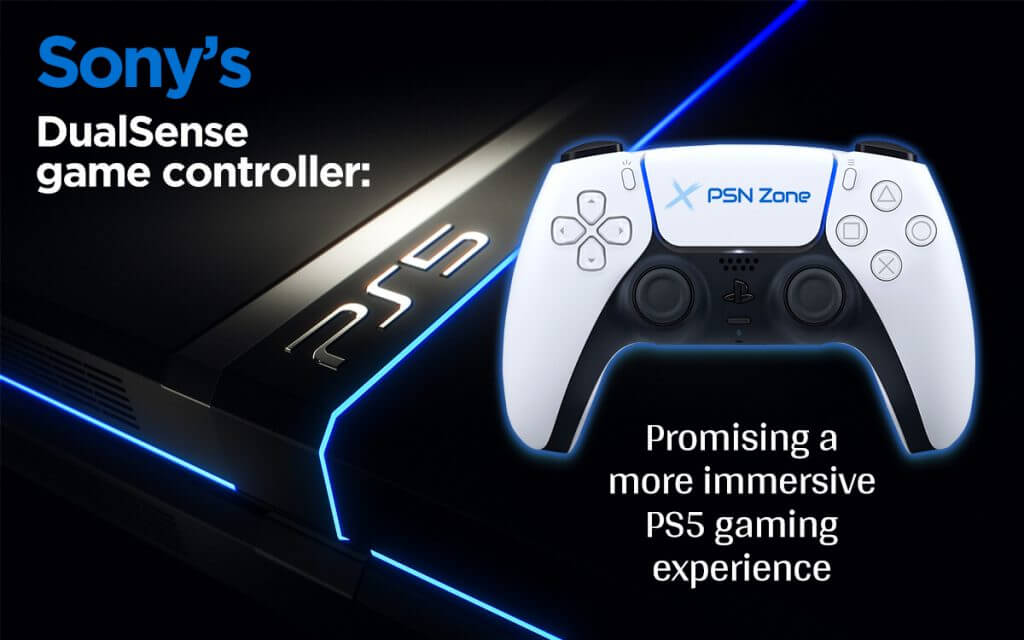Sony’s DualSense Game Controller

Sony’s cancelled its much-anticipated June 4th PS5 gaming announcement amid the ongoing unrest across the US, and even parts of the rest of the world. However, the king of gaming consoles (and associated accessories!) promised to reschedule in the very near future. It’s clear that the re-scheduled event will still focus primarily on the new gaming titles that’ll be available on their new PS5 platform – scheduled for launch during the Holiday season 2020. But without a superstar gaming controller, no amount of developer wizardry can deliver the immersive experience that gamers crave for.
Sony’s DualSense game controller promises just that kind of immersive experience. Read on to find out why!
Controller journey through the years
Before we talk DualSense, it might make sense to take a look back at what brought Sony to where they are today, and how far they’ve come. PlayStation enthusiasts and analysts alike agree that, over the years, PS controllers haven’t really changed significantly in appearance. From the vintage PlayStation (1994), to successive transitions to PS2 (2000) and PS3 (2006) – their profiles looked remarkably similar.




The introduction of PS4 (2013), with its DualShock 4 wireless controller, was likely the first real “deviation” from 2000-style PS2 controllers. But then, to be honest, it too was nothing more than a “souped-up” version of the PS3 controller. From a distance, you’d understandably be forgiven if you couldn’t immediately differentiate one controller iteration from the other. And that’s putting it mildly!
Overall, while underlying technology may have changed, like the Share button on the PS4 controller, physical PlayStation controller architecture has never had a revolutionary make over in decades. Incremental profile upgrades left successive iterations of Sony’s flagship gaming consoles with a largely similar-looking controller.
Taking the next step forward
Given this backdrop, of almost no significant outward change to the PS controller profiles over the years, and especially after the 5-star feedback the company received for its DualShock 4 innovation – even company insiders wondered what they could do next to top DualShock. The unanswered question was: How does one build upon (PS4 controller) success that’s already met with resounding gamer approval? The company was looking for answers so it wouldn’t disappoint its fan base.
That’s when Sony decided more needed to be done than simple tweaks or adjustments to their next-gen controller design. An intensive consultation process followed, where the world’s gaming king reached out to a slew of constituents and stakeholders. From avid gamers to developers, hardware manufacturing partners, designers and business partners. A clear pattern of the future started to gradually emerge.
The result of the consultation made one thing clear to Sony. Everyone advised them not to mess with what was already working well. It’s always difficult to build upon a winning formula – but you don’t do it by gutting what works! And so, it came to pass – the company agreed to keep most of what made DualShock 4 a hit, and carry it into its next generation of controllers. Of course, there was the need to refine the design and add more functionality – but no plan to phase out anything that the most recent controller delivered.
Of notable interest to the design and development team was the sense of touch that gamers truly enjoy when engaged in what they love most – playing intense, high-impact games! The radical DualShock 4 touch-sensation features were a starting point, and the company decided to build upon them for the next iteration of their flagship controller. Sony worked closely with game developers to build an improved sense of immersion that game producers delivered through the controller.
This enhanced sense of touch/feel would mean gamers could receive greater sense of participation and engagement in whatever virtual world they stepped into when playing their favorite titles. Whether it was firing a heavy-duty assault rifle, pulling the bow strings as an arrow is fired, or scaling a sheer cliff with bare hands…they’d get real life vibrations, shocks and sensations ripple through the controller, immersing them even deeper into virtual reality than they could with previous iterations of their favorite game controller.
Making the next-gen controller reality
Clearly, this was an ambitious effort on Sony’s part – to deliver a heightened sense of immersion like no other gaming controller had ever offered. But the engineers and designers at Sony were up to the task. Never a team to be beaten by a challenge, the group at Sony thought up some ingenious features to add to DualShock 4, that would take it to the next level and bring the next generation of controllers to life.
One of Sony’s creative ideas, that made its way into DualSense, was what the design team called haptic feedback. To the uninitiated, “haptic” relates to the perceptions delivered through touch and body movement, as gamers manipulate or move objects around. It is this feeling that creates the illusion of interacting or engaging with objects in virtual environments.

A great example of haptic feedback is the grittiness gamers feel as they drive a vehicle through a muddy field. The crunchy sense of the wheels grinding and turning furiously, even as the vehicle struggles to gain traction, sends a distinct sensation through the players body – through the controller. It’s as if the gamer is sitting right there in the drivers’ seat, struggling to keep the car in check at high speeds, as it slips and slides out of control. And that’s the kind of immersive experience DualSense promises!
But the Sony controller design team didn’t stop there!
Another innovative feature, that DualSense comes equipped with, is what the design team called adaptive triggers. This neat little feature draws its intelligence straight from the gaming software environment. Sony incorporated adaptive trigger features into both L2 and R2 buttons of their next-gen controller. So, what does that mean to gamers? Well, depending on the situation a gamer faces in a game, this new (software-driven) feature increases or reduces the tension one feels on the buttons.
Think of adaptive triggers in a real-life situation – like discharging a personal firearm (a handgun or pistol) versus firing a heavy-duty assault rifle or machine gun. The point-and-click nature of the lighter weapon (the pistol) doesn’t require too much pressure exertion when pulling the trigger. But it’s a whole different ball game when firing the heavier weapon. You need more pressure, and experience greater tension on the trigger of the later than the former.
Thanks to DualSense’s adaptive trigger functionality, game developers can now vary the amount of pressure gamers must exert on the L2 and R2 buttons to perform a specific function. It’s the same when opening a bottle of pop, or prying lose a rusted valve in an underground bunker filled with treasure – one requires little force, while the other needs a lot of it. Adaptive triggers sense what’s needed, and delivers the required experience through the controller.
Subtle and sleek enhancements
Of course, the holy grail of gaming controllers is: Smaller and lighter! Given the increasing complexities of today’s gaming situations – requiring unique interactions from the controller; as well as the additional functionality added to each iteration of the controller – Sony really had its work cut out for it. For instance, the new adaptive trigger functionality itself were a challenge: How to deliver such features without adding to the overall profile of the controller.
 |  |
And then, there’s the challenge of extending the life of the rechargeable wireless DualSense battery. Typically, longer-life power storage equals more weight. The Sony team, however, worked through those challenges to come up with a sleek design, which not only makes the final product look smaller than it is, but it also feels comfortably lighter than what industry watchers expected.
Sony broke ranks with its controller color scheme too. Traditionally, since inception of PlayStation back in 1994, the console maker favored uni-color controllers – beige/off-white for the original PlayStation controller, and shades of black for all subsequent controller iterations. All that changes with DualSense. Sony opted for a two-toned color scheme for its next-gen controller.
And now, your new controller comes with a built-in microphone array. This is a cool feature if you want to have a quick chat with gaming buddies, but don’t want the hassle of slugging on your headset. Clearly, while this is a convenient feature to have, it doesn’t replace the headset. You’ll still need one to truly enjoy the full gaming experience that DualSense promises.
The old DualShock 4 light bars have changed positions too. Where previously they sat atop of the controller, they now straddle either sides of DualSense. This neat revamp gives the new controller a pop, making it look “space-ageish”. Some have even likened it to the helmeted heads of Star Wars storm troopers. Now that’s an appropriate look for something that promises to be next-gen?
Building on Share
Since we talked about the PS4 Share button earlier, lets delve a little more on it – just to highlight how the next-gen DualSense moved forward. We’ve already mentioned the unrivaled success of the PS4 Share button, and how gamers and industry watchers alike gave Sony kudos for coming up with that innovation. Well…Share is no more in Sony’s next gen controller. “Hang on, just a minute!”, I hear you say. “Didn’t you say earlier that Sony isn’t taking away any of the PS4’s success? So, what’s this about doing away with the well-liked Share button?”
Well, while it’s no longer called the “Share” button, and it may no longer be obvious on DualSense, Sony hasn’t done away with the concept of sharing. In fact, as promised, they took the Share button’s functionality, built upon it, and now call it the “Create” button. Gamers will now be able to create larger-than-life gaming content, and then share it with their universe of like-minded gamers. To date, details on this “unique” functionality are scant – but stay tuned. Sony has promised to release more on this (and other) DualSense features and functionality over the coming weeks.

